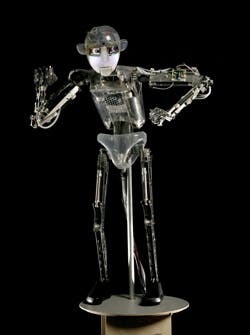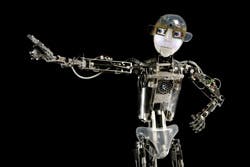Edited by Mary C. Gannon
senior associate editor
RoboThespian — a unique interactive robot created by Engineered Arts — uses Festo fluidic muscles to deliver a lifelike performance.
Engineered Arts Ltd, Penryn, Cornwall, U.K., which specializes in hi-tech multi-media, has created an unique interactive robot — named RoboThespian — that is currently wowing audiences around the world. Initially developed to provide entertaining semi-autonomous theatrical performances, the life-sized robot's capabilities have recently been expanded to facilitate far higher levels of audience interaction. The robot's siblings are now much in demand at science and technology centers as highly animated public orators and front-of-house presenters.
The first generation of RoboThespian robots were developed in January 2005, when Engineered Arts was commissioned to create a troupe of robotic actors to perform at the Eden Project's 'Mechanical Theatre'. The initial design work focused on the necessary mechanical engineering and control systems, resulting in a hugely popular installation piece that featured tireless performers who needed no lunch. However, it soon became obvious that audiences craved more than a one-way relationship — they wanted to interact with the robots. So Engineered Arts embarked on an extensive development program to create a set of fully-integrated hardware modules for controlling the robots' various valves and motors, and added internet connectivity to the control software, to facilitate access to web-based public information sources such as Wikipedia.
The first interactive RoboThespian was exhibited at a conference hosted by the Association of Science-Technology Centers in Los Angeles, in November 2007. The robot's repertoire included a series of song and dance routines, and for the first time, it was able to respond to its audience vocally and through reactive physical movement. Eventually, people now wanted to be able to shake RoboThespian by the hand, and to make the robot perform their own routines.
Adding a little muscle
As a consequence, Engineered Arts has now added articulated hands, an additional axis in each arm, and feedback sensors on all movement axes. In total there are 31 powered axes — six per arm, four per head and two per leg, plus four in the head, two in the body and one for rotating the entire figure through 180° — each of which features full proportional control. The robot contains six dc motors, but all of its major movements are controlled by Festo DMSP series fluidic muscles. These very high power-to-weight pneumatic actuators essentially comprise a flexible tube with reinforcing fibers in the form of a lattice structure; they contract as they are filled with compressed air, and elongate again when the air is removed. Fluidic muscles are ideal for highly dynamic, short move length applications such as this, and their peristaltic type movement is exceptionally smooth and lifelike.
Festo currently produces three variants of fluidic muscles, with diameters of 10, 20 and 40 mm. The company is also considering developing a 5 mm version, but as yet testing and development is still underway. However, as Will Jackson, director of Engineered Arts, points out, “For obvious reasons, we are very interested in small diameter fluidic muscles — they would make great RoboThespian fingers! For this type of non-industrial application, involving relatively low-duty cycles, we could probably live with the performance figures that Festo is already achieving, so we're keen to participate in the product evaluation process. In fact, this degree of cooperation typifies our experience with Festo — we have enjoyed superb service from the company, all the way along the line. Their technical support is second to none, their local representative is almost part of our team, and their products are always delivered on time and to budget.”
Giving the audience control
The first interactive RoboThespian was installed at the Goonhilly Future World exhibition in Cornwall back in March 2008. It features a new remote control console fitted with a 19-in. touch-sensitive screen, linked to the robot via an industry-standard LAN; the control software employs an advanced graphical user interface with 'drag and drop' editing facilities, enabling visitors to create their own movement sequences using a virtual on-screen robot, and to then watch them being performed live by RoboThespian.
Engineered Arts is already seeing considerable interest in RoboThespian from commercial organizations and businesses. The company recently installed a robot at the newly modernized Industrion Science Park in Kerkrade in The Netherlands — where it speaks fluent Dutch and German — as well as a Spanish-speaking model at the Parque de las Ciencias open-air museum in Granada, Spain. Engineered Arts is also in the process of commissioning a robot for the Copernicus Science Centre in Warsaw, Poland.
For more information, visit www.robothespian.com, www.engineeredarts.co.uk, or www.festo.com.
Click here to see a video of RoboThespian in action.


